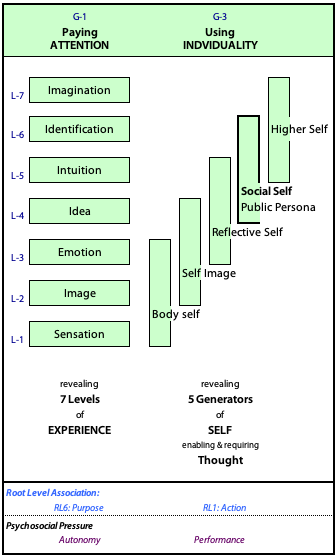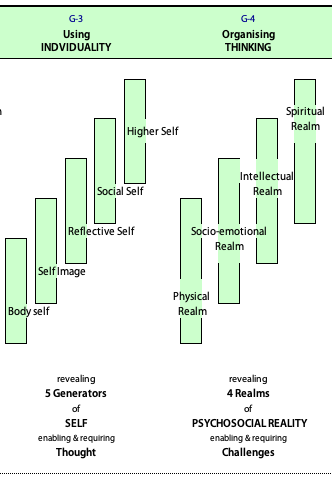Public Persona
Orientation

During the investigation of within the , different manifestations of the self were identified as being generated by the need to use individuality. Click on the upper thumbnail at right to see the .
Using the frameworks in this section, mainly unconsciously but often with full awareness, will unavoidably create for each of us a recognizable identity or . This is the basis for what will be taxonomically labeled, a . This persona is identifiable by others in relation to your efforts to succeed at work, in business and in other public settings.
Different social selfs may be developed in other more private contexts
e.g. when on holiday or within a family setting.
Any development and management of your «self» requires thought, and this occurs within the four (see lower thumbnail). It has been evident throughout this satellite that getting ahead in society takes a great deal of thought, mostly within the socio-emotional and intellectual realms.

At the most elemental level, the is constituted by . But where do these elements come from? The answer appears to be that are to be found in the requirements for as identified in the previous section.
We can briefly consider why this is the case.
Approach to Analysis
The final framework in the sequence that completes any Q-Arena is the Tree pattern developed from the Groupings in the Structural Hierarchy. In this case, we have determined:
• The : Ways to interact for benefit.
• The : Cooperating for results.
• The: Ensuring financial security.
• The ): Determinants of social standing
• The : Looking out for Yourself.
The task now is to clarify the, and it is a general principle that the final Tree in a structural hierarchy triplet is the context for the original Tree i.e. . But a more concrete descriptor would be preferable and we may now have it.
In the various (organizations, societal institutions and philosophy schools), the spiral structural hierarchy trees appear to be about participation.
In this , the is unequivocally about a person's participation in society and conditions . This both validates a general theme and confirms the choice of name.![]() More
More
- Continue to an outline of the investigation in this section.
Originally posted: 10-Oct-2025.